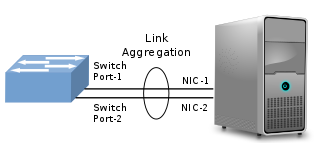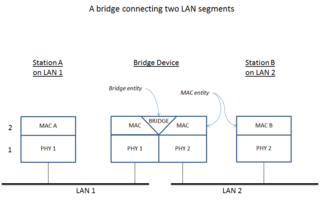A network switch is networking hardware that connects devices on a computer network by using packet switching to receive and forward data to the destination device.
The Spanning Tree Protocol (STP) is a network protocol that builds a loop-free logical topology for Ethernet networks. The basic function of STP is to prevent bridge loops and the broadcast radiation that results from them. Spanning tree also allows a network design to include backup links providing fault tolerance if an active link fails.

A virtual local area network (VLAN) is any broadcast domain that is partitioned and isolated in a computer network at the data link layer. In this context, virtual refers to a physical object recreated and altered by additional logic, within the local area network. Basically, a VLAN behaves like a virtual switch or network link that can share the same physical structure with other VLANs while staying logically separate from them. VLANs work by applying tags to network frames and handling these tags in networking systems, in effect creating the appearance and functionality of network traffic that, while on a single physical network, behaves as if it were split between separate networks. In this way, VLANs can keep network applications separate despite being connected to the same physical network, and without requiring multiple sets of cabling and networking devices to be deployed.
A multilayer switch (MLS) is a computer networking device that switches on OSI layer 2 like an ordinary network switch and provides extra functions on higher OSI layers. The MLS was invented by engineers at Digital Equipment Corporation.

In computer networking, link aggregation is the combining of multiple network connections in parallel by any of several methods. Link aggregation increases total throughput beyond what a single connection could sustain, and provides redundancy where all but one of the physical links may fail without losing connectivity. A link aggregation group (LAG) is the combined collection of physical ports.

EtherChannel is a port link aggregation technology or port-channel architecture used primarily on Cisco switches. It allows grouping of several physical Ethernet links to create one logical Ethernet link for the purpose of providing fault-tolerance and high-speed links between switches, routers and servers. An EtherChannel can be created from between two and eight active Fast, Gigabit or 10-Gigabit Ethernet ports, with an additional one to eight inactive (failover) ports which become active as the other active ports fail. EtherChannel is primarily used in the backbone network, but can also be used to connect end user machines.
The Multiple Spanning Tree Protocol (MSTP) and algorithm, provides both simple and full connectivity assigned to any given virtual LAN (VLAN) throughout a bridged local area network. MSTP uses bridge protocol data unit (BPDUs) to exchange information between spanning-tree compatible devices, to prevent loops in each Multiple Spanning Tree instance (MSTI) and in the common and internal spanning tree (CIST), by selecting active and blocked paths. This is done as well as in Spanning Tree Protocol (STP) without the need of manually enabling backup links and getting rid of switching loop danger.

A network bridge is a computer networking device that creates a single, aggregate network from multiple communication networks or network segments. This function is called network bridging. Bridging is distinct from routing. Routing allows multiple networks to communicate independently and yet remain separate, whereas bridging connects two separate networks as if they were a single network. In the OSI model, bridging is performed in the data link layer. If one or more segments of the bridged network are wireless, the device is known as a wireless bridge.

A router on a stick, also known as a one-armed router, is a router that has a single physical or logical connection to a network. It is a method of inter-VLAN routing where one router is connected to a switch via a single cable. The router has physical connections to the broadcast domains where one or more VLANs require the need for routing between them.
A switch virtual interface (SVI) represents a logical layer-3 interface on a switch.
Network load balancing is the ability to balance traffic across two or more WAN links without using complex routing protocols like BGP.
A forwarding information base (FIB), also known as a forwarding table or MAC table, is most commonly used in network bridging, routing, and similar functions to find the proper output network interface controller to which the input interface should forward a packet. It is a dynamic table that maps MAC addresses to ports. It is the essential mechanism that separates network switches from Ethernet hubs. Content-addressable memory (CAM) is typically used to efficiently implement the FIB, thus it is sometimes called a CAM table.

Multi-link trunking (MLT) is a link aggregation technology developed at Nortel in 1999. It allows grouping several physical Ethernet links into one logical Ethernet link to provide fault-tolerance and high-speed links between routers, switches, and servers.

Private VLAN, also known as port isolation, is a technique in computer networking where a VLAN contains switch ports that are restricted such that they can only communicate with a given uplink. The restricted ports are called private ports. Each private VLAN typically contains many private ports, and a single uplink. The uplink will typically be a port connected to a router, firewall, server, provider network, or similar central resource.
VLAN hopping is a computer security exploit, a method of attacking networked resources on a virtual LAN (VLAN). The basic concept behind all VLAN hopping attacks is for an attacking host on a VLAN to gain access to traffic on other VLANs that would normally not be accessible. There are two primary methods of VLAN hopping: switch spoofing and double tagging. Both attack vectors can be mitigated with proper switch port configuration.
The Time-Triggered Ethernet standard defines a fault-tolerant synchronization strategy for building and maintaining synchronized time in Ethernet networks, and outlines mechanisms required for synchronous time-triggered packet switching for critical integrated applications and integrated modular avionics (IMA) architectures. SAE International released SAE AS6802 in November 2011.
IEEE 802.1aq is an amendment to the IEEE 802.1Q networking standard which adds support for Shortest Path Bridging (SPB). This technology is intended to simplify the creation and configuration of Ethernet networks while enabling multipath routing.
A data monitoring switch is a networking hardware appliance that provides a pool of monitoring tools with access to traffic from a large number of network links. It provides a combination of functionality that may include aggregating monitoring traffic from multiple links, regenerating traffic to multiple tools, pre-filtering traffic to offload tools, and directing traffic according to one-to-one and many-to-many port mappings.
TRILL is a networking protocol for optimizing bandwidth and resilience in Ethernet networks, implemented by devices called TRILL switches. TRILL combines techniques from bridging and routing, and is the application of link-state routing to the VLAN-aware customer-bridging problem. Routing bridges (RBridges) are compatible with, and can incrementally replace, previous IEEE 802.1 customer bridges. TRILL Switches are also compatible with IPv4 and IPv6, routers and end systems. They are invisible to current IP routers, and like conventional routers, RBridges terminate the broadcast, unknown-unicast and multicast traffic of DIX Ethernet and the frames of IEEE 802.2 LLC including the bridge protocol data units of the Spanning Tree Protocol.

Broadcast, unknown-unicast and multicast traffic is network traffic transmitted using one of three methods of sending data link layer network traffic to a destination of which the sender does not know the network address. This is achieved by sending the network traffic to multiple destinations on an Ethernet network. As a concept related to computer networking, it includes three types of Ethernet modes: broadcast, unicast and multicast Ethernet. BUM traffic refers to that kind of network traffic that will be forwarded to multiple destinations or that cannot be addressed to the intended destination only.







